
The Pentatomoidea are a superfamily of insects in the Heteroptera suborder of the Hemiptera order. As Hemiptera, they share a common arrangement of sucking mouthparts. The roughly 7000 species under Pentatomoidea are divided into 21 families. Among these are the stink bugs and shield bugs, jewel bugs, giant shield bugs, and burrower bugs.

Pentatomidae is a family of insects belonging to the order Hemiptera, generally called shield bugs or stink bugs. Pentatomidae is the largest family in the superfamily Pentatomoidea, and contains around 900 genera and over 4700 species. As hemipterans, the pentatomids have piercing sucking mouthparts, and most are phytophagous, including several species which are severe pests on agricultural crops. However, some species, particularly in the subfamily Asopinae, are predatory and may be considered beneficial.
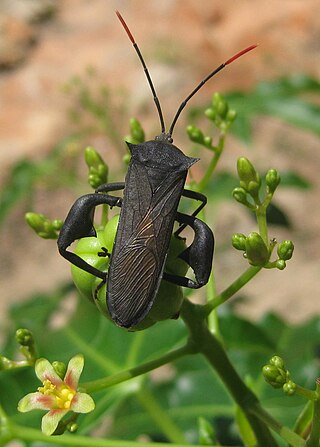
Coreidae is a large family of predominantly sap-sucking insects in the Hemipteran suborder Heteroptera. The name "Coreidae" derives from the genus Coreus, which derives from the Ancient Greek κόρις (kóris) meaning bedbug.

Scutelleridae is a family of true bugs. They are commonly known as jewel bugs or metallic shield bugs due to their often brilliant coloration. They are also known as shield-backed bugs due to the enlargement of the thoracic scutellum into a continuous shield over the abdomen and wings. This latter characteristic distinguishes them from most other families within Heteroptera, and may lead to misidentification as a beetle rather than a bug. These insects feed on plant juices from a variety of different species, including some commercial crops. Closely related to stink bugs, they may also produce an offensive odour when disturbed. There are around 450 species worldwide.

Pentatominae is a subfamily of Pentatomidae, a family of shield bugs. This subfamily is the largest one within the Pentatomidae, having 4937 species classified in 938 genera. Species in this subfamily are phytophages and several of them are considered agricultural pests. Some invasive pentatomines such as Halyomorpha halys and Bagrada hilaris have been considered household pests. Higher systematics of the group have been revised by Rider et al.

The Pentatomomorpha comprise an infraorder of insects in the true bug order Hemiptera. It unites such animals as the stink bugs (Pentatomidae), flat bugs (Aradidae), seed bugs, etc. They are closely related to the Cimicomorpha.

The Lygaeoidea are a sizeable superfamily of true bugs, containing seed bugs and allies, in the order Hemiptera. There are about 16 families and more than 4,600 described species in Lygaeoidea, found worldwide. Most feed on seeds or sap, but a few are predators.
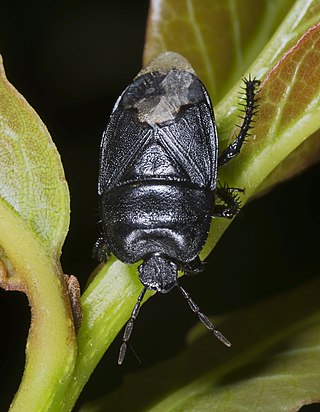
Cydnidae are a family of pentatomoid bugs, known by common names including burrowing bugs or burrower bugs. As the common name would suggest, many members of the group live a subterranean lifestyle, burrowing into soil using their head and forelegs, only emerging to mate and then laying their eggs in soil. Other members of the group are not burrowers, and live above the soil layer, often in close association with plants. Several species are known as agricultural pests.

The Harpactorinae are a large subfamily of the Reduviidae. About 300 genera and 2,000 species worldwide have been described. Some of the species of the genera Zelus, Pselliopus, Sinea, and Apiomerus are of interest as biological pest control agents.

The Corimelaeninae are a subfamily of shield bugs within the family Thyreocoridae. It has often been treated as a family (e.g.), but the name Thyreocoridae, published in 1843, has nomenclatural priority over Corimelaenidae, published in 1872.
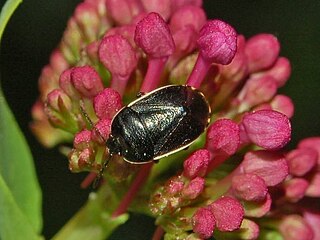
Sehirinae is a subfamily of burrowing bugs belonging to the family Cydnidae.

Urostylididae is a family of true bugs and is considered a basal or "primitive" family within the stink-bug lineage. They are found only in Asia. Older works used the spelling Urostylidae but this clashes with the name used for a protozoan family and a spelling correction (emendation) has been suggested that also avoids the confusion created by homonyms. The family name Urolabididae has also been used for some members in the past.
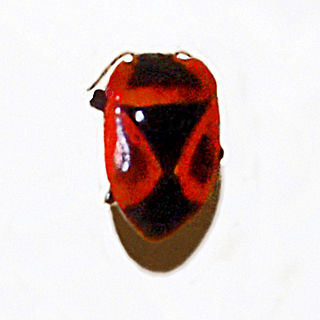
Parastrachiidae is a family of true bugs belonging to the ordo Hemiptera. It had been considered to be a subfamily under family Cydnidae, but it was raised to family status in 2002.

Cydninae is a subfamily of burrowing bugs in the family Cydnidae. There are about 11 genera and at least 40 described species in Cydninae.
Cydnoides albipennis is a species of black bug in the family Thyreocoridae. It is found in North America.
Cydnoides is a genus of black bugs in the family Thyreocoridae. There are about five described species in Cydnoides.

Oxycarenidae is a family of true bugs in the order Hemiptera. There are more than 20 genera and 140 described species in Oxycarenidae.

Carpocorini is a tribe of stink bugs in the family Pentatomidae. There are more than 100 genera in Carpocorini.
Galgupha is a genus of ebony bugs in the family Thyreocoridae. There are more than 30 described species in Galgupha.
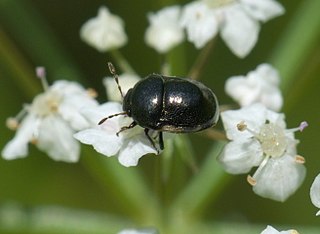
Corimelaena is a genus of ebony bugs in the family Thyreocoridae. There are at least 20 described species in Corimelaena.

















